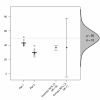The problem of pseudoreplication in neuroscientific studies: is it affecting your analysis?
- PMID: 20074371
- PMCID: PMC2817684
- DOI: 10.1186/1471-2202-11-5
The problem of pseudoreplication in neuroscientific studies: is it affecting your analysis?
Abstract
Background: Pseudoreplication occurs when observations are not statistically independent, but treated as if they are. This can occur when there are multiple observations on the same subjects, when samples are nested or hierarchically organised, or when measurements are correlated in time or space. Analysis of such data without taking these dependencies into account can lead to meaningless results, and examples can easily be found in the neuroscience literature.
Results: A single issue of Nature Neuroscience provided a number of examples and is used as a case study to highlight how pseudoreplication arises in neuroscientific studies, why the analyses in these papers are incorrect, and appropriate analytical methods are provided. 12% of papers had pseudoreplication and a further 36% were suspected of having pseudoreplication, but it was not possible to determine for certain because insufficient information was provided.
Conclusions: Pseudoreplication can undermine the conclusions of a statistical analysis, and it would be easier to detect if the sample size, degrees of freedom, the test statistic, and precise p-values are reported. This information should be a requirement for all publications.
Figures

Similar articles
-
A host of issues: pseudoreplication in host-microbiota studies.Appl Environ Microbiol. 2024 Aug 21;90(8):e0103324. doi: 10.1128/aem.01033-24. Epub 2024 Jul 31. Appl Environ Microbiol. 2024. PMID: 39082810 Review.
-
Don't let spurious accusations of pseudoreplication limit our ability to learn from natural experiments (and other messy kinds of ecological monitoring).Ecol Evol. 2015 Oct 26;5(22):5295-5304. doi: 10.1002/ece3.1782. eCollection 2015 Nov. Ecol Evol. 2015. PMID: 30151132 Free PMC article.
-
[Pseudoreplication in ecological research: the problem overlooked by Russian scientists].Zh Obshch Biol. 2003 Jul-Aug;64(4):292-307. Zh Obshch Biol. 2003. PMID: 14524226 Review. Russian.
-
Pseudoreplication is a pseudoproblem.J Comp Psychol. 2009 Nov;123(4):421-33. doi: 10.1037/a0013579. J Comp Psychol. 2009. PMID: 19929110
-
Pseudoreplication conventions are testable hypotheses.J Comp Psychol. 2009 Nov;123(4):444-6. doi: 10.1037/a0016093. J Comp Psychol. 2009. PMID: 19929112
Cited by
-
Representations of the intrinsic value of information in mouse orbitofrontal cortex.bioRxiv [Preprint]. 2024 Oct 16:2023.10.13.562291. doi: 10.1101/2023.10.13.562291. bioRxiv. 2024. PMID: 39416043 Free PMC article. Preprint.
-
A host of issues: pseudoreplication in host-microbiota studies.Appl Environ Microbiol. 2024 Aug 21;90(8):e0103324. doi: 10.1128/aem.01033-24. Epub 2024 Jul 31. Appl Environ Microbiol. 2024. PMID: 39082810 Review.
-
ULV: A robust statistical method for clustered data, with applications to multi-subject, single-cell omics data.ArXiv [Preprint]. 2024 Jun 10:arXiv:2406.06767v1. ArXiv. 2024. PMID: 38947924 Free PMC article. Preprint.
-
The Lack of Synapsin Alters Presynaptic Plasticity at Hippocampal Mossy Fibers in Male Mice.eNeuro. 2024 Jul 3;11(7):ENEURO.0330-23.2024. doi: 10.1523/ENEURO.0330-23.2024. Print 2024 Jul. eNeuro. 2024. PMID: 38866497 Free PMC article.
-
Gastrointestinal nematode infection during pregnancy and lactation enhances spatial reference memory and reduces indicators of anxiety-like behaviour in uninfected adult female mouse offspring.Parasitology. 2024 Jun;151(7):722-731. doi: 10.1017/S0031182024000696. Epub 2024 May 29. Parasitology. 2024. PMID: 38808523 Free PMC article.
References
-
- Scott S, Kranz JE, Cole J, Lincecum JM, Thompson K, Kelly N, Bostrom A, Theodoss J, Al-Nakhala BM, Vieira FG, Ramasubbu J, Heywood JA. Design, power, and interpretation of studies in the standard murine model of ALS. Amyotroph Lateral Scler. 2008;9:4–15. doi: 10.1080/17482960701856300. - DOI - PubMed
-
- Hurlbert SH. Pseudoreplication and the design of ecological field experiments. Ecol Monogr. 1984;54(2):187–211. doi: 10.2307/1942661. - DOI
Publication types
MeSH terms
LinkOut - more resources
Full Text Sources

